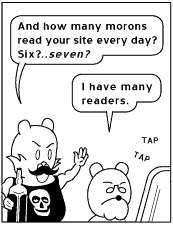
Progress. Bluetoothing an image to my machine works. Emailing one still doesn’t. But getting there slowly anyway.
Technorati doubleheader
First: The creator of Technorati, Dave Sifry, commented on my note about bloggers and journalism last week. He notes:
…if people stop linking to you, your Technorati ranking will drop – and if a blog is removed from a blogroll, the ranking will drop faster. I’ve also been talking with folks like Kevin Marks about his Vote Links initiative, which would place an extra attribute in a link tag to show whether you are approving of the link, neutral, or negative, which can then be used to make further judgements about things like notoriety.
Which puts a little more muscle behind “shunning.” And makes the subtle social dynamics of the blog world replicate middle school just a little more. I’m almost kidding—I think “vote links” is a fricking brilliant idea and long overdue. Just… wow.
Anyway, onto the second point: Doc points to the newest feature at Technorati: blog keyword search. Beating Google to the punch, over 360,000 blogs indexed and ready—plus an API.
The search is pretty cool, though I wonder if indexing by the Technorati ranking of the parent site alone is the right thing to do. After all, someone may only have three inbound links but be the total authority on some obscure search term.
Phone success
Yes, there was happiness at the end of the road. After obtaining a Bluetooth adapter for my home machine, I experimented with trying to sync my contacts (using iSync and trying to send one at a time from the Address Book) with no luck. I then turned to the web. MacFixitForums were unhelpful, but the MacInTouch reader reports on iSync pointed out something I had missed, namely that the phone tries to use port 3004 for the mRouter discovery protocol, and that opening ports 3000 through 3004 enables the communication.
I made the change, turned the firewall off and on, and then had to reboot—I suspect because I had to force quit iSync when it failed the first time. After the reboot I was able to synchronize my address book to my phone, all 1471 contacts processed seamlessly.
Remaining issues:
- What’s up with mailing photos from the phone? Worked yesterday, doesn’t work today.
- Bluetooth File Exchange doesn’t work. At all. Can’t move a file, can’t create a new folder.
- Why won’t iSync transfer iCal items to the phone? There’s a calendar on there after all.
Phone update
So a little quick update on my phone drama: I splurged a little over the weekend and got a Nokia 3650. This is the phone that’s been in a few carriers’ commercials—the one with the built in camera on the back. So I wanted to figure out how to get some of the more advanced features enabled, and I tried to sync the phone up to my PC via infrared.
Nothing. I never got the phone to connect—every time I tried, the software on the PC reported a failure in the sync layer. And now I can’t send emails from the phone, which worked fine before.
I think there’s a law of increasing complexity in cell phone technology, and I think I just crossed over the line between usable and crazy with this new phone. Of course, I can always try putting a Bluetooth adapter on my computer and seeing whether that works any better’adding another layer of complexity.
Realistically it will be a while before I can blog or send photos from this thing…
Mothman reaches Charlottesville
A new Mothman update today: Jim has reached Charlottesville in time for his ten-year reunion. You can read the story so far of Jim’s through-hike of the Appalachian Trail from the Mothman Chronicles page (or subscribe in RSS for new updates!).
Why we bust our humps
A friend called while I was in the back garden swearing at a thorny, recalcitrant wild strawberry vine that was growing over some of our “real” plants. He asked what I was up to. I responded, “We’re out in the garden finding all sorts of mystery weeds to uproot.”
There was a pause, and he responded dubiously, “Well, I guess that sounds like a good thing to do on a Saturday.”
I thought about it after I got off the phone with him. It’s not so much the uprooting weeds, it’s the results afterwards.
Which is rather the point of a lot of things, I think.
Adam: xserve ahoy
Adam Curry writes: “Tuesday my new Xserves arrive. This is good news for users of schoolblogs, my jamby and diaries.com.”
Since the latter is Esta’s weblog host, that’s good news for her too.
A year ago today…
…was a very cold (55°) and very wet graduation ceremony at MIT.
Sorry I didn’t blog yesterday. It’s definitely the time of year when it’s easy for outdoor projects to consume every iota of my time and attention. Even if it does hit 95° (which is, I think, a record for the Seattle area in June). More rocks to dig in today, and a garden (someone else’s) to visit.
A belated happy anniversary to my parents. Esta arranged for the anniversary to be called out on the loudspeaker at the baseball game they went to on Thursday night.
Lou Reed takes no prisoners
It’s true, and it’s in a magazine, Kung Fu magazine to be exact. Apparently Lou has been studying Tai Chi since the early 80s, and he’s hooked up with a pretty major league master, Ren Guangyi. It appears Master Ren may be touring with Lou this summer, which means I’ll get to see him in action when the show comes to Seattle. Should be pretty cool.
Measuring blogs, part 2
Measuring blogs, part 1
I was doing some thinking about measuring blog usage today—not how many blogs there are, but how far blog content reaches. Such measurement isn’t a priority for most blog publishers, but what about traditional media companies that have to decide whether to make the RSS plunge as a business investment? So I came up with a few observations:
- Reach is a traditional media measurement that calculates how much of the potential viewership (I would use the word “audience,” but we all know that’s a screwed up metaphor for online activity) can see a particular piece of content. This is a hard measure to get, since the content is exposed not only on one’s website but in an XML file that can be exposed in lots of different readers, and when the headline can be posted on lots of different sites. Other traditional media metrics based on exposure, including unique users and cost per impression, also go right out the window.
- Likewise, coming to a decent clickthrough measurement is difficult, since clickthrough is defined as clicks per people that viewed the link (see above).
So what does that leave us with? What about treating RSS like newsletters? Subscriber count is hard to gather since there’s no “formal” subscriber process to get an RSS file. Likewise download count for the RSS file: while the latter is feasible, platforms like Manila don’t render a static XML file that can be tracked in a traditional web hit log, and counters like SiteMeter only track files that can embed their counting code (which leaves out RSS). And it’s hardly a meaningful or reliable measure of exposure without unique users, or knowing whether the downloaded file actually contains new content.
So what’s a media company to do? Other than take it on faith, I mean. Maybe starting with Technorati? Or Google’s PageRank?
Too many questions, not enough good answers.
Are bloggers reporters?
A funny confluence of news stories this morning:
- First, the organizers of a leading tech conference say they’ll have to review their nondisclosure policies after reporting “gag rules” failed to stop two attendees from blogging the proceedings.
- Second, the executive editor and managing editor of the New York Times resign in the aftermath of the Jayson Blair scandal (NY Times coverage here.)
On first glance, these two items don’t seem to have a lot to do with each other. But as Dave points out, there’s a thin line between the two stories: “an intelligent person with a weblog is a reporter.” Salam Pax proves that, at least.
But do we really want to be “treated” like reporters?
This is the critical thing. The fuss at the Times led to the resignation of its senior editors for one reason—reputation. The Times had earned a reputation for integrity and thoughtful, substantive reporting that it couldn’t afford to lose. There were consequences for their actions. In general, there is a higher standard of behavior expected from the media and a higher level of formality when dealing with the media, not just because they report things, but because people believe what they say and act on that belief, sometimes with serious consequences.
So if weblog authors want to be taken seriously as journalists, they have to be prepared to live up to a higher standard of behavior—and admit when they screw up. The only problem is, the tools we have for weblog “reputation”—PageRank and Technorati—don’t take those screwups into account. Or do they? If you stop getting pointed to by people, pretty soon that will be apparent through Technorati. Google seems to have a longer decay time, on the other hand. My old weblog site (same content as the new one, different home) has fallen one point of PageRank from its high water mark of 6, although the blog hasn’t been updated since November 21, 2002. But maybe not getting pointed to by other bloggers is bad enough—like a “shunning,” only online.
Apple and the indies
Fun news from the world of iTunes: Apple will be meeting with a bunch of indie labels, among them Matador and local faves Sub Pop, tomorrow to discuss what it takes to participate in the Apple/iTunes Music Store. Story first reported on MTV.com; MacCentral has a confirmation from Apple.
Of course, if they’re just talking tomorrow, it’s anyone’s guess about how long it will take for non-major-label content to show up in the ’Store. But it’s a kick to think that Kinski, Ugly Casanova, L7, the New Pornographers, Pretty Girls Make Graves, Cat Power, Interpol, Guided By Voices, and, yes, the Jesus and Mary Chain could show up in an iTunes window next to the current headliners, who include No Doubt, the Doors, and Luther Vandross.
Esta discovers Tiffany
Esta: The Blue Box. Speaking from personal experience, Esta, it’s a slippery slope. Pretty soon you’ll be waiting for the Tiffany catalog with bated breath and picking through the newspaper ads, muttering, “If I don’t eat this month…”
… What? It’s for my wife. Get over yourself.
Big Star, or How I Learned to Stop Worrying and Love the 70s
There are a few bands that surface over and over again in interviews with rock stars as serious influences on serious musicians. Others rattle the landscape even if they inhabit their own space, free of any imitators or hangers on. Usually they’re bands you’ve never heard, or even heard of. In the past I’ve been richly rewarded by seeking out some of these bands—like the Velvet Underground, Robert Johnson, Robert Cage, Gemma Hayes, Godspeed You! Black Emperor, Gastr Del Sol, Dock Boggs, and others.
But I always put off listening to Big Star, despite hearing artists like REM, the Replacements, and the dBs claim them as touchstones. Why? No good reason, really, except that they were from the 70s (their song “In the Street” is the theme song of That 70s Show—in a cover version by Cheap Trick(!!)), and that one of their founding members was Alex Chilton, with whom I associated hundreds of bad a cappella covers of his classic song with the Box Tops, “The Letter.” But I kept wondering. Could they be as good as everyone said they were?
Nah. They were’t that good. They were better.
My first inkling of this was listening to “You and Your Sister,” a rare b-side by the co-founder of the band, Chris Bell (cut less than a year before his death in a car crash in 1977), on the most recent Oxford American Music Issue cd. The voice is haunting and high, the lyrics pained and honest (“Your sister says that I’m no good/I’d reassure her if I could/All I want to do/Is spend some time with you…friends fail every day…”), the melody gorgeous and simple. Okay, I thought, it’s time.
So I picked up Big Star’s first two albums, #1 Record and Radio City, on a single disc budget compilation. And fell in love. The first song, “Feel” has high strained vocals that uncannily recall 70s scream rock (think Cheap Trick, Led Zeppelin, or “Rock and Roll Coochie Coo”) coupled with a chorus that could have been on Pet Sounds. And then the instrumental break busts out an incredible brass line that reminds you that, yes, Big Star came from Memphis. (Most of the rest of the songs mercifully dispense with the scream rock vocals.) “In the Street,” while not as swaggering as the Cheap Trick cover version, is somehow more interesting in the places it goes, sounding a little Beach Boys and REM by turns. Other songs presage Uncle Tupelo and bring echoes of the Byrds. And those are just some of the songs from the first album; Radio City is even stronger. No wonder radio wasn’t ready for Big Star. It’s the sort of music that’s almost too good to share.


